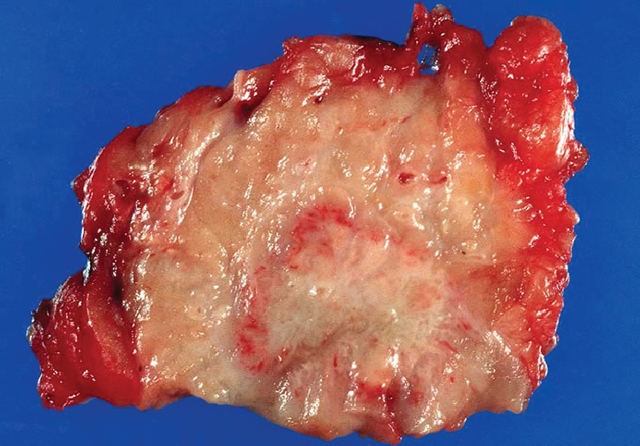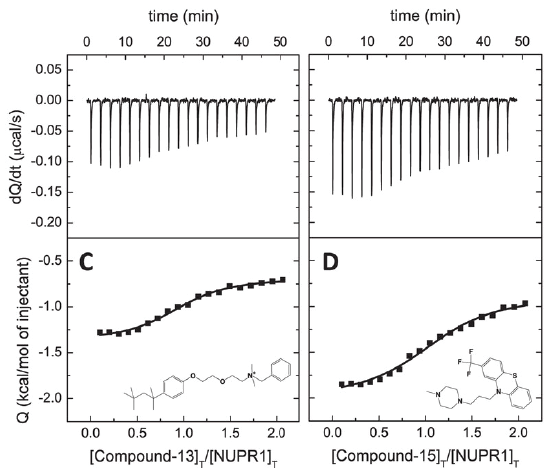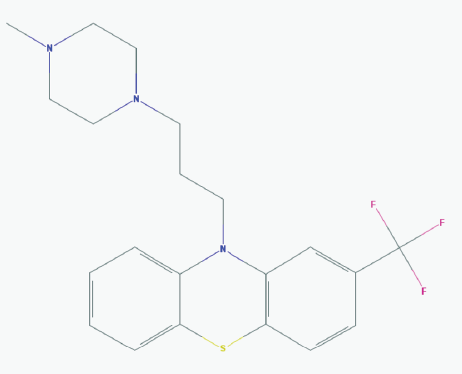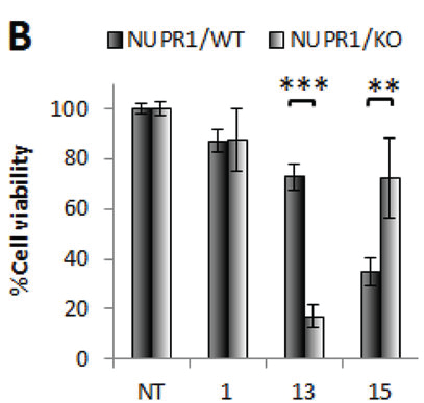Anti Anxiety Medication Found To Stop A Protein Involved In Pancreatic Cancer Development
This post describes work published January 5th 2017 in the journal Nature: Scientific Reports titled "Identification of a Drug Targeting an Intrinsically Disordered Protein Involved in Pancreatic Adenocarcinoma."

Background Information
Adenocarcinoma
A carcinoma is a type of cancer defined as an abnormal growth in epithelial tissue. Epithelial cells are those which line the surfaces our organs and blood vessels. Adenocarcinomas (as seen in the thumbnail image) are a specific subset of carcinomas with a glandular origin, and gland in this context means any tissue in the body that produces hormones. Adenocarcinomas don't have to be a part of a gland per say, they just have to have a similar hormone secreting activity (or at least the cellular components necessary to be able to secrete, even if they aren't actively doing so). Adenocarcinoma tumors are malignant, meaning they are capable of spreading and invading other types of tissues. These are very serious cancers.
Intrinsically Disordered Protein
This article pertains to proteins known as intrinsically disordered proteins. [2] These proteins are weird in that they lack the highly structured form that most proteins have, and was generally thought to be required. Rather intrinsically disordered proteins have a flexible, rapidly changing structure. Intrinsically disordered proteins are involved in a variety of cellular regulatory pathways and often times do end up with more static structures when they interact with their targets.
Trifluoroperazine
Trifluoroperazine is an anti-psychotic medication predominantly used to treat schizophrenia. Trifluoroperazine is thought to function by blocking dopamine receptors, and can result in minimizing the hallucinations characteristic of the disorder. [3]
The Article
In the article the authors were testing a variety of compounds against Intrinsically Disordered Proteins. The intrinsically disordered protein they were dealing with is called "Nuclear Protein 1" or NUPR1. NUPR1 is known to be present in high levels in pancreatic adenocarcinoma, involved in metastasis and cellular invasion, and the down-regulation of which causes deterioration of the cancer cells.[4]
They did a significant amount of biophysical characterization of two compounds which they lovingly called compound-13 and compound-15.

What you are looking at above are traces for isothermal titration calorimetry. This technique is used to monitor the energy released when two molecules interact with one another, and can be used to determine how strongly a compound interacts with a protein. This may not look like much to you, but through it they can determine the sort of dosing necessary for a compound to interact with the target (in this case these two compounds binding to NUPR1). The two compounds were shown to bind with similar affinities ( 3 - 5 µM... for those that are curious.)
Another important thing to take away from this figure is what the identity of compound-15 is, trifluoperazine, they call it compound 15 throughout the manuscript but reference this compounds name in the discussion. Luckily we can compare the structure they provided us with, with the structure for trifluoperazine:

If you look back at the ITC structure, you can see that this structure for trifluoperazine and the one included for compound-15 are the same so compound 15 is in fact trifluoperazine.

Looking at the above figure, the authors were testing the various compounds and looking at their effect on mouse cellular pancreatic adenocarcinoma viability (aka whether cells lived or died when in the presence of these compounds). You can see that most of the compounds did nothing except for compounds 13 and 15. The last lane "oxa" refers to a DNA damaging agent Oxaliplatin, which is a positive control (meaning it will kill the cells for sure).

Finally in this experiment the authors were comparing the effects of the compounds on two different mouse pancreatic adenocarcinoma cell lines. One "WT" was expressing the NUPR1 protein, the other "KO" was not. They showed that these two compounds had a different effect with compound 15 (trifluoperazine) being more effective at killing the cells when NUPR1 was present then when it wasn't.
TL;DR
Researchers have identified that a anti-psychotic medication called trifluoperazine has some efficacy in killing pancreatic adenocarcinoma cells, due to its interacting with the protein NUPR1. The NUPR1 protein is involved in helping the cancer cells spread, and killing its activity results in death of the cells.
It is always a good thing when additional uses are found for medications which are already available for treating other diseases, especially when the additional use may help people in their battle against an especially aggressive form of pancreatic cancer.
Sources
- https://peerj.com/articles/2913/
- https://en.wikipedia.org/wiki/Intrinsically_disordered_proteins
- https://www.ncbi.nlm.nih.gov/pubmed/14974020
- https://www.ncbi.nlm.nih.gov/pubmed/19153668
- http://www.nature.com/cdd/journal/v21/n10/full/cdd201474a.html
All non Cited Images Are Available Under Creative Commons Licenses
Any Gifs Are From Giphy.com and Are Also Available for Use Under Creative Commons Licences
Articles published in Nature: Scientific Reports are available for re-use under a Creative Commons License
If you like my work, please consider giving me a follow: @justtryme90. I am a PhD holding biochemist with a love for science. My future science blog posts will cover a range of topics in the biology/chemistry fields.
Thank you for your continued support of my work! I appreciate all those who follow me (and those who don't too).
Nice article! I posted it to my Biology of Aging Google+ Community.
Wow, thank you very much! I am glad you enjoyed the post!
I would have sent you the link, but Google+ does not give full access unless you are a member, but this is a vague impression of what the community is like:
https://plus.google.com/communities/101513179882783511389?utm_source=chrome_ntp_icon&utm_medium=chrome_app&utm_campaign=chrome
My community does have 7000 members.
Are you on Google+? Their Science Community is massive (683,000 members). It would be like epic awesomeness if Steemit #science got that huge. It will be interesting to see what develops when Steemit has some form of specialized communities as forecast in the recent Roadmap.
I have a google+ account, maybe I should focus on trying to get my steemit articles more attention there. I didn't realize there were so very many science readers there. Perhaps posting more material could bring more of them here and help continue to improve the quality of steemit science content.
When specialized communities become a thing here we have been discussing making a #steemstem community, to focus on quality science writing.
Some Ideas
Google+ STEM Community has 69,000 members to recruit from. What I would suggest is post your articles on Steemit AND Google+ and have some kind of mechanism to quantify the results you get.
In the past, I did have some success recruiting Google+ people from the Transhumanism communites to join Tsu (a now defunct blog-for-pay social media). I sent a personalized sales letter to each individual and got a surprising number to join and participate on Tsu. I don't see why it would not work for Steemit.
It does help if you have built up some reputation on Google+ rather than sending a a cold sales letter. If they have seen your name around they will be more adventurous about signing up for a new social media.
You have posted a large body of work here on Steemit that you can share over on Google+. That will get +1s, comments and some reposts. Each post on Google+ has an area that tracks all activity; here is where you get your prospect list because they have interacted with you, recognize your name and like what you do.
Nonetheless, Some moderators on Google+ may not support your recruiting on their turf, but once you get someone to read your pertinent article here on Steemit, then they are fair game for recruitment.
Of course, you could just bring people here without data and hope for the best, but I used to be a professional saleman and I believe in quantifying everything to maximize sales. Furthermore, I know that you as a scientist know that it's all in the data.
Science is like a top 10 community on Google+. The interest is there. Personally, I see no reason why Science etc. couldn't become the premier community here on Steemit.
Thank you for the advice I will give it a shot!
Wow this post was tough. Had to read it twice to really get everything (or at least to think getting everything). This is good news. What is the next step? Human tests?
Just a silly question now. Do you know why the error bar for the compound-1 (let's assume I guessed the naming scheme :p) is so large compared to the others. Not that it matters (since from the next figure, this compound seems to be pretty inert), but by curiosity.
There was one more figure in the paper where they stopped the growth of human tumors grafted onto mice with Trifluoperazine as well. I thought about including it too, but wanted to keep this shorter. So as far as their next step I would suspect more direct tests in animal models (rather than cell culture). However as this looks not to be done by one of the pharmaceuticals (it's a variety of universities in Spain and hospitals, I don't see any pharma) so I am not certain what the pipeline would be. They did not discuss a next step for their finding, just that they observed the efficacy of Trifluoperazine for this case.
Why is the error bar so big for compound-1? Good question. I do not know, they are reporting standard deviation rather than SE so one terrible replicate (where all the cells died) could really throw massive error into the mix (especially considering things were only done in triplicate).
This was a difficult paper for me to read and interpret as the authors were not always entirely clear (which is surprising considering its in a nature sub journal) as to what was what.
I really dislike the non-disclosure of what the compounds were.
Often the best articles are not the clearest... It may also depend on the referee...
Thanks anyhow for your answer :)
Of course!
Hopefully this will lead to a better way to fight it. Pancreatic cancer is one nasty cancer. We catch it so late, and the pancreas is in a very vascular area making its spread very easy.
In addition adenocarcinomas are inherently quite metastatic, so combined with the vascularity of the pancreas makes it quite a troubling cancer. Any additional tools in the fight against it are welcome IMO, especially if those tools are currently available for other uses.
Most certainly! It's weird to think about it... but an insulinoma is a terrible tumor to get but, for a potential of pancreatic cancer, it is nothing compared to an adenoma.
An awesome post @justtryme90 some really great info. Thanks
Thank you for reading, your support and most of all your comment! :D
Your so welcome
Added some additional information and clarified some sentences.
This post has been ranked within the top 25 most undervalued posts in the first half of Feb 16. We estimate that this post is undervalued by $6.69 as compared to a scenario in which every voter had an equal say.
See the full rankings and details in The Daily Tribune: Feb 16 - Part I. You can also read about some of our methodology, data analysis and technical details in our initial post.
If you are the author and would prefer not to receive these comments, simply reply "Stop" to this comment.